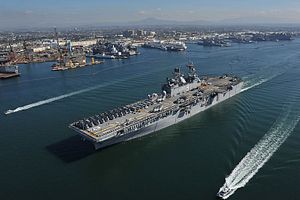Some ideas are undead. Even false ones are hard to kill. Exhibit A: the conceit that the U.S. Navy is bigger, or stronger, or something, than the next X navies combined. The Naval Diplomat was dismayed not long ago to hear a seasoned scholar of maritime affairs retail a version of this line. She, he, or it contended that the navy is “more powerful” than the next sixteen navies.
Implication: the U.S. Navy could fight an alliance among its sixteen strongest potential opponents with a 50-50 chance of victory — or better. Whoa!
And wrong. Egregiously so. This factoid is nothing more than a tonnage figure. It means the U.S. Navy outweighs the next sixteen (or thirteen, the usual figure bandied about during the 2012 election campaign) navies. That’s all. Framed in those terms, the American advantage doesn’t sound so overpowering, does it? Still less is tonnage a sound basis for decisions about how many and what types of ships you lay down, or what combat systems you build into them.
Now, bulk isn’t entirely meaningless. Indeed, it’s a must for a navy like America’s that journeys and does battle across intercontinental distances. Bigger hulls house more fuel, stores, and ammunition. More storage capacity for bullets, beans, and black oil (as U.S. Navy sailors of a certain, ahem, vintage like to say) means more rounds out the barrel, the ability to undertake longer voyages, and greater time on station once in theater. None of these are minor things.
A navy that displaces more, then, may be stronger than a slimmer opponent. But not necessarily. If tonnage were all that mattered — as our factoid maintains — then the Maersk Line, with its heavyweight container ships, would be the world’s strongest navy. The freighter Emma Maersk, after all, displaces a burly 165,000 metric tons, to the supercarrier USS Ronald Reagan‘s welterweight 103,000. Is the unarmed merchantman stronger than the nuclear-powered flattop because it displaces over half-again as much?
Hardly. You have to look past brute tonnage numbers and other simple metrics to take a navy’s true measure. Though necessary when cruising far from home, size is insufficient.
At most, then, tonnage is an enabler for combat strength. It says little about speed, protection, or armament — the crucial determinants of a warship’s combat efficacy. Still less does it take the tactical setting into account. Operating off foreign shores exposes American task forces not just to an enemy fleet but to an array of land-based weaponry, notably anti-ship missiles, combat aircraft, and short-range patrol craft and submarines festooned with missiles and torpedoes.
Such weaponry forms part of an opponent’s sea power. It can augment even a feeble surface fleet, acting as the great equalizer between a weak local power defending its home ground and a global sea power trying to impose its will thousands of miles from its own coasts. The idea that size is power obscures such disquieting yet inescapable realities. It nevertheless refuses to die. All the more reason why we should drive a stake through its heart — lest lawmakers act on it, making ill-informed decisions about the size and shape of the U.S. Navy.
Speaking of which, think about the politics of factoids. If the U.S. Navy is really bigger than the next sixteen, or thirteen, navies combined, and if aggregate tonnage equals battle strength, then it stands to reason that Washington can enact severe cutbacks to the fleet at little to no risk. Reductions will merely narrow an insurmountable U.S. margin of naval supremacy to something less insurmountable but still overbearing. Is that a message maritime advocates really want to send to those holding the power of the purse?
Enter the Royal Navy. At its zenith, from 1889 to World War I, Great Britain maintained a “two-power standard.” London, that is, sized its fleet to match the next two largest navies put together. If perchance these competitors joined forces, a Royal Navy built to this standard still stood an even chance of winning. Better than even, considering Jack Tar’s fame for seamanship and gunnery. British leaders trusted to human excellence to decide the issue.
Yet they had it easy. Navies were largely symmetrical in those thrilling days of yesteryear. That simplified matters. Size was a decent proxy for fighting power when battle fleets made up largely of capital ships bearing big guns squared off. That was before the era — an era that persists to this day — when small craft could carry armament comparable to that of capital ships. A destroyer couldn’t tote big guns back then. A lowly missile boat or sub can fire munitions comparable to those of a capital ship today — and to the same deadly effect.
It gets worse. Seldom, a century ago, did land-based sea power play much part in naval warfare. The range of shore gunnery was measured in a few miles — an afterthought when you consider the vast scale of the oceans and seas. It made more sense back then to measure fleet against fleet, downplaying external variables like guns mounted on land. No longer do maritime strategists and tacticians enjoy the luxury to simplify problems thus.
You get the point. Assuming the U.S. Navy is bigger and stronger than a consortium of many, many prospective competitors means assuming its margin of supremacy dwarfs that of any past seagoing hegemon — including Great Britain in its prime. Yet the U.S. Navy fleet numbers only 288 as of April 7. If we use the British two-power standard as a benchmark, and starting with a U.S. fleet of 288 hulls, how many ships would our supposedly sixteen-power navy need to meet the standard set by history’s greatest empire? Two hundred? One hundred? Fewer?
Absurd results all. So let’s dispense with foolish one-liners about naval power before they get America in real trouble. Where’s that wooden stake when we need one?

































